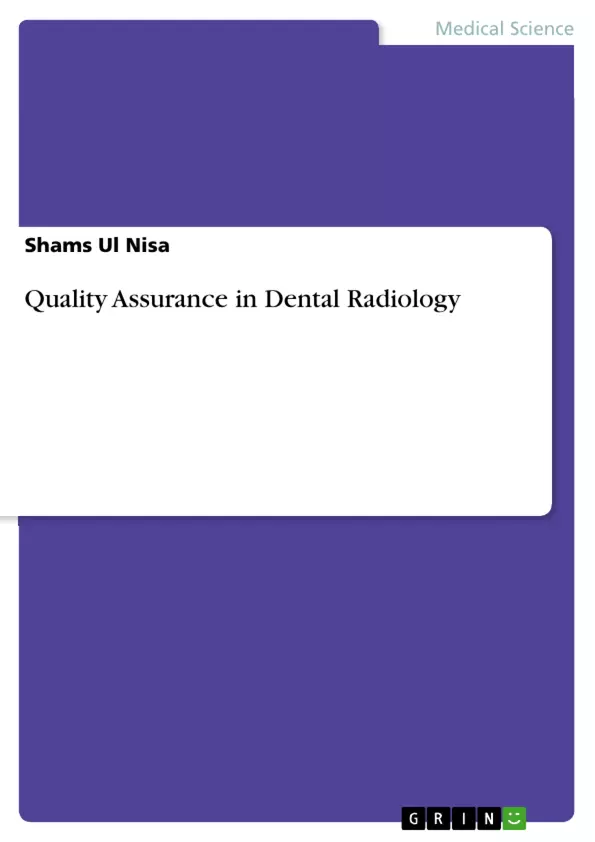Quality assurance has been defined as the organized effort by staff to ensure the production of high quality radiographs providing consistently adequate diagnostic information at the lowest possible cost and with the least possible exposure of the patient to radiation.
An adequate quality radiograph is one which provides the required diagnostic information. However the quality of radiograph depends upon several contributory factors. Where the practitioners is in any doubt about the reasons for poor radiographic quality, it is helpful to systematically target the problem areas. This is achieved by carrying out a film reject analysis.
Inhaltsverzeichnis (Table of Contents)
- Quality Assurance In Dental Radiology
- Film Reject Analysis
- Reasons for Rejection
- Solving the Problems
- Operator Technique
- Periapical Radiography
- Bite wing Radiography
- Panoramic Radiography
- Cephalometric radiography
- The X-ray Set
- The Image Receptor
- The Darkroom
- Processing
- Monitoring Radiographic Processing
- Film Reject Analysis
Zielsetzung und Themenschwerpunkte (Objectives and Key Themes)
This text explores the essential aspects of quality assurance in dental radiology, focusing on identifying and resolving issues that lead to poor radiographic quality. Its primary goal is to guide dental practitioners in achieving consistently high-quality radiographs for optimal diagnostic information while minimizing patient radiation exposure.
- Film reject analysis as a tool for quality assessment
- Identifying and rectifying common causes of radiographic defects
- Optimizing radiographic technique for enhanced diagnostic accuracy
- Importance of proper darkroom procedures and processing techniques
- Minimizing radiation exposure while maintaining diagnostic quality
Zusammenfassung der Kapitel (Chapter Summaries)
- Quality Assurance In Dental Radiology: Introduces the concept of quality assurance in dental radiology, emphasizing the need for consistently high-quality radiographs to provide adequate diagnostic information while minimizing patient radiation exposure. It underscores the importance of a systematic approach to identifying and resolving issues affecting radiographic quality.
- Film Reject Analysis: Outlines the methodology of film reject analysis as a crucial step in quality assurance. It introduces a simple reject log for recording and analyzing radiographs produced in the practice, specifically focusing on rejected or poor-quality images. The chapter emphasizes the value of this approach for identifying and addressing major problems affecting radiographic quality.
- Reasons for Rejection: Presents a detailed analysis of common reasons for film rejection, categorizing them into various factors like processing faults, excessive X-ray exposure, fogged film, inadequate X-ray exposure, low contrast, unsharp images, and poor positioning. For each reason, it provides specific potential causes and outlines corresponding remedies.
- Solving the Problems: This chapter highlights the key areas targeted during quality assurance evaluation through film reject analysis. It emphasizes the importance of operator technique, the X-ray set, the image receptor, the darkroom environment, and the processing of radiographs. It emphasizes that even with advanced equipment, poor radiographic technique can lead to subpar results.
- Operator Technique: Focuses specifically on the operator's role in ensuring high-quality radiographs. It identifies common problems in intra-oral radiographic technique such as film bending, misdirection of the X-ray beam, and overlapping of critical areas, emphasizing the importance of proper technique for minimizing distortion and maximizing diagnostic accuracy.
Schlüsselwörter (Keywords)
This text focuses on key concepts such as quality assurance, dental radiology, film reject analysis, radiographic technique, X-ray exposure, darkroom procedures, and processing techniques, all contributing to the production of high-quality diagnostic radiographs while ensuring patient safety through minimized radiation exposure.
- Quote paper
- Shams Ul Nisa (Author), 2016, Quality Assurance in Dental Radiology, Munich, GRIN Verlag, https://www.grin.com/document/337556



